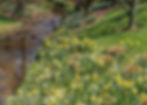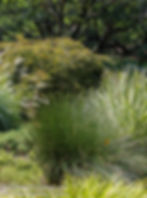Deer-Resistant All-star Lineup
- Helen Newling Lawson
- Apr 11, 2018
- 2 min read
Updated: Jul 23, 2020
Here at Spot On Deer-Resistant Gardens, I want to show how many different plants and planting combinations can be deer-resistant. Still, there are a few plants I call my deer-resistant all-stars: ones that are reliably deer-resistant for most gardeners and fit into most garden designs. I hope you'll find them to be top performers, too.
Please note: If you buy through one of the Amazon Affiliate links on this page, I'll earn a small commission but it will cost you nothing.
Japanese Maple
Acer palmatum

There are so many small trees to recommend for a deer-resistant garden, but I have to put Japanese maple on the all-star roster for its multi-season interest, graceful form, and variety of sizes, colors, and growth habits to fit most any garden design.
Boxwood
Buxus spp.

Boxwood is the classic choice for a formal garden, but it works equally well framing a cottage garden. English boxwood can be finicky and slow-growing, but varieties like 'Wintergreen' Korean boxwood can quickly fill in to add structure and year-round beauty to your garden. If boxwood blight is an issue in your area, try native lookalike inkberry (Ilex glabra). 'Gembox' is one new variety to try, with a more compact, formal growth habit.
Hellebore
Helleborus spp.
Hellebores (or Lenten Rose) were the plant that first tipped me off to the idea that I could have a beautiful garden if I just focused on plants the deer weren't eating. I absolutely love the look of these plants, from the mass of evergreen foliage; to the texture of their coarse, palmate leaves; and of course, the long-lasting flowers in Easter egg colors.
Daffodil
Narcissus spp.
How lucky are we that a plant as pretty and easy to grow as daffodils is also deer-resistant?

These cheery bulbs fit a range of garden styles, from formal to naturalized woodlands. They will multiply over the years, so you get more of a good thing with no additional effort on your part.
Grasses

Between true ornamental grasses and grass-like plants like sedges and Acorus, most every grassy plant is deer-resistant. The variety of
plants that fit into this category mean that they can be used in almost any landscape or match any growing condition, from moist shade to dry, rocky soil. That variety can also allow you to create a soothing tapestry by mixing colors, textures, and forms, like this combination at Gibbs Gardens. Many also can be food for birds, butterfly larvae, and other wildlife, but watch out for the non-native varieties that drop invasive seeds.
Ferns
Like grasses, ferns as a category are generally deer-resistant. And also like grasses, they come in a range of textures, sizes, and forms, and can be evergreen or deciduous. They do like some shade, but differ in moisture needs depending on variety. They make a wonderful f

iller for woodland gardens, especially ones that are too shady (or deer-riddled) for much else to grow. The emerging fronds also make a good cover for daffodil foliage that is starting to die back.
Like this article? Pin it!




